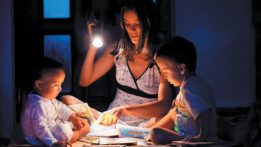
Over 70% of the world’s plants and crops depend on pollination to survive. However, because of urbanization, loss of habitat, and agricultural practices, our pollinator populations are declining rapidly. Who are these pollinators? They are bees and butterflies, of course, but also moths, bats, beetles, and birds. The wind is a major pollinator, too, but mainly of grasses and trees, and it needs no assistance. All of our living pollinators do, however, as they have important roles to play in assuring continued production of flowering and fruiting plants. Furthermore, insects in general are a food-chain essential for the bird populations. By creating a habitat in your yard that nurtures pollinators, you become part of a vital conservation effort. Whether you start small with a five-gallon planter of larval foods or start big by planting a meadow of native wildflowers, every effort contributes to the support and maintenance of our shared ecosystem, and every effort will reward us with a richer, more abundant, and more interesting environment.
One of the easiest ways to start a pollinator garden is by incorporating pollinator-friendly flowers, shrubs, and trees into your landscape whenever you replace a plant or create a new gardening space. As you probably know, certain species of butterflies (such as the Monarch) depend on a native plant not only to provide food but also to sustain young larvae. Other species lay their eggs on various herbs, such as fennel, parsley, and other host plants, so that the young caterpillars have an immediate food source. So, when you bring in new plants for pollinators, it’s a good idea to consider the whole life-cycle when making your plant choices. Be advised that butterfly larvae can practically defoliate a plant in just a few weeks; however, consider that unkempt and chewed up plant as pollinator success instead of garden failure. Plus, it’s interesting to observe these little chewers, and the plant will almost certainly recover after the caterpillar season is over. From an aesthetics perspective, you can always plant caterpillar host plants in a not-so-prominent spot.
Pollinator gardens encourage the presence of insects, so pesticides have no place there; instead, you can use beneficial insects, such as ladybugs, to control unwanted inhabitants, such as aphids, thrips, and scale insects, or hand-pick and destroy them. Try to resist the impulse to react negatively to (relatively) unattractive or intimidating insects such assassin bugs and parasitic wasps—which eat the bad bugs too. Beware of annual and perennial flowering plants that have been treated with neonicotinoids to make them “pest free.” Neonicotinoids are insecticides that are used to protect plants against sap-sucking and leaf-chewing insects. They are absorbed by all parts of the plant and contained in the nectar and pollen produced by these plants. Any of the bees, butterflies, and other insects visiting these plants will be harmed by ingesting them. Several of our local nurseries have banned such treated plants.
What should you plant? Well, that’s the fun part, but sometimes the sheer number of beautiful annuals and perennials in garden centers can leave us feeling overwhelmed and helpless. In order to help make sense of it all and help narrow your choices for a pollinator garden, consider first the areas or types of pollinator gardening that draw your interest. Are you fascinated by certain species of pollinators or plants? Do you want to work primarily with native plants and wildflowers? Perhaps you want to start with the more commonly available “introduced” annuals and perennials, or maybe you want to study our native bees. Make a list of plants that support your interests.
Next, consider your gardening conditions, such as how much sun and shade your garden gets and the type of soil you have, noting any problem areas, such as low-drainage or hot, dry sandy areas. As so often advised, pick the right plant for the right place. This helps you avoid not only the frustration of plant failure but also the loss of money you could be spending on other new plants rather than replacements. Remember, too, that sometimes you may have to move a plant around a few times before it finds its happy place.
The following plant lists are provided here to assist you in your selections or at least give you a starting point when you visit the nurseries. The lists are by no means exhaustive, so feel free to do more research. Space limitations prevent photographs and individual plant descriptions of each plant; however, once you have formulated your general preferences, you can look deeper into plant characteristics. Be adventurous. For every four reliable starter plants, maybe buy one chancy, unfamiliar species. You never know what beauties they may become. At the same time, buy from reliable sources. Back in the 1960s, my dear aunt once purchased a packet of “Jack-in-the-Beanstalk” seeds from a grocery for her children, and my uncle then teased her unmercifully for failing to read the packet’s fine print: “Kudzu seeds.”
HERBS
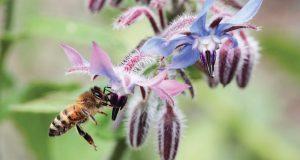
Many culinary herbs are very pollinator friendly and offer a wide variety of foliage, textures, and colors, so consider planting a few extra pots. Many herbs can be grown from seed. Pollinator favorites include annuals, such as basil, cilantro, marjoram and oregano. It has been said that borage (also easily grown from seed) refills with nectar every two minutes and that insects love it. The leaves taste like cucumber and are good in summer drinks, and the blue flowers are a nice addition to salads. Borage is tall, so it should go to the back of a border. Perennial herbs—such as chives, fennel, mint (for the flowers), rosemary, sage, and thyme—all attract pollinators. Make sure you keep the mint potted, as many varieties are invasive. Swallowtails love dill, and black swallowtails will flock to fennel, which will host their eggs, caterpillars, and the butterfly chrysalises. Anise hyssop and bee balm (bergamot) attract bees, and the leaves can be used in teas.
WILDFLOWERS
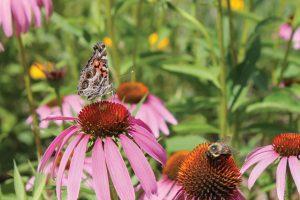
The Florida Wildflower Foundation website (flawildflowers.org) has a wealth of information on growing Florida native wildflowers, including a 24-page downloadable PDF booklet. The Wildflower Foundation lists the following as its Top 20 list of easy-to-grow wildflowers: milkweed, goldenaster, false rosemary, lanceleaf tickseed (Coreopsis), twinflower, blanketflower (Gaillardia), verbena, dune sunflower (Helianthus), St. John’s wort, blazing star (Liatris), spotted beebalm, silver-leaved aster, black-eyed Susan (Rudbeckia), wild petunias, sage, skullcap, Senna, rosinweed, goldenrod (Solidago), and aster. Taller varieties of wildflowers for the back of the garden include Joe-Pye weed and rosinweed while shorter varieties for the front are the coneflowers, tickseeds, blanketflowers, and black-eyed Susan. Consult the foundation’s website for many planting suggestions and garden plans.
FRIENDLY NON-NATIVES
While being mindful of the importance of native plants to our pollinators, we can still include some of the many “introduced” plants that attract butterflies, bees, and hummingbirds, such as cannas, coral honeysuckle, marigolds (the ones with the “eye” are said to be more attractive to butterflies), nasturtiums, pentas, and salvias. Zinnias and cosmos are two other very easy-to-grow-from-seed flowers that will attract lots of pollinators. Zinnias are a favorite of monarch and swallowtail butterflies as well as hummingbirds; although, the double-bloom varieties make nectar less accessible and therefore less attractive to pollinators. Taller varieties, such as Tall State Fair Zinnia Mix and California Giant Zinnias, are a big draw for butterflies. Of the shorter types, the Dwarf Profusion attract swallowtails and red admirals. Zinnias and other annuals should be dead-headed to encourage a longer blooming period.
SHADE PLANTS

Our choices of flowering plants become more limited with shade, but the following shade-tolerant varieties attract pollinators: astilbe (especially the pink and purple shades), balloon flower, bleeding heart, columbine, coralbells, flowering hostas, lemon balm, and torenia. These are all good choices for (relatively) cooler, shadier areas of the garden.
PLANTS FOR WET OR BOGGY SOIL
Astilbe, bee balm, blazing star (Liatris), bottle brush, cannas, helianthus, Joe-Pye weed, milkweed, monarda, rudbeckia, tall ironweed, and white false indigo (Baptisia) all tolerate wet conditions.
HUMMINGBIRD PLANTS

Our little hummers are very attracted to red, nectar-rich plants, such as bottlebrush, cleome, coral bean, impatiens, petunias, and salvia. They also love butterfly bushes, columbine, firebush, monarda, pentas, shrimp plant, verbena, and wild azaleas.
TREES
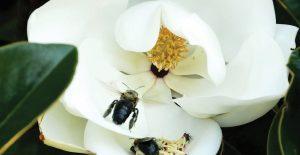
Flowering and fruiting trees have always been an important source of pollen for honeybees, but they also support other pollinators, including native bees and birds. If you are replacing trees that fell during the recent storms, please consider planting a pollinator-friendly native tree. Locally available native trees that are more wind resistant include bald cypress, East Palatka holly, live oak, sand live oak, Savannah holly, southern magnolia, and yaupon holly. Natives that do well in shade or under a pine canopy include ashe magnolia, fringe tree, leucothoe, red buckeye, and redbud. The following trees are good choices for large open spaces: black tupelo, persimmons, red maple, river birch, Shumard oak, and tulip poplar. Nurseries that specialize in native plants can offer a lot of information and assistance when choosing a tree.
The flowers of our citrus trees also attract bees, butterflies, and moths. University of Florida/IFAS recommends the following as hardy in our area of North Florida: kumquat (Nagami and Meiwa), Meyer lemons, navel oranges (Hamlin, Valencia, Temple), and tangelos (Orlando or Minneola). Be sure to purchase certified nursery plants from registered nurseries in order to slow the spread of citrus disease. Citrus trees are most productive in full sun but will tolerate light shade. Fertilize with products designed for citrus to replace nutrients used up in fruit production. You can also grow citrus in containers, with the advantage that by moving the pot for winter protection, you can grow some of the lemon and lime trees popular in South Florida. Be sure that the pot is large enough for the plant and provides adequate drainage.
Fruit trees suitable for our area include apples (Anna and Reverend Morgan), peaches (Tropic Beauty), pears (Baldwin), plums (Gulf beauty), native cherries, and native crabapples. If you are planting fruit trees for production of fruit as well as pollinators, remember that the use of insecticides to encourage production is harmful to pollinators. Consult your local University of Florida/IFAS Extension Office or the website for more information on growing fruit trees and non-chemical means of addressing fruit pests. It may be easier to simply plant a fruit tree for the beauty of the flowers in spring, the provision of nectar and pollen for bees, and lastly, the enjoyment of whatever fruit it provides.
VINES
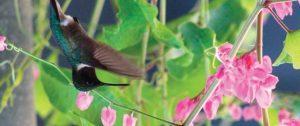
The most common vines for pollinators in our area are coral vines (a hummingbird favorite) and passionflower vines (beloved by gulf fritillaries and black zebra butterflies for a larval food source). Carolina jessamine, crossvine, Dutchman’s pipe, pipevine, trumpet creeper, and Virginia creeper are also good vine choices for pollinators. Mexican flame vine nectar is a big attractant for monarchs, sulfurs, and fritillaries, but this vine is hardy only to Zone 9, so it would need cold protection or overwintering.
LARVAL FOODS

Food plants sources for butterflies and other pollinators span perennials to annuals, weeds to wildflowers, and trees to shrubs. Native plants that provide larval food include pipevine, milkweed, wild white indigo, partridge pea, passion vine, sensitive plant, porterweed, and violets. The website Dengarden also lists five host plants it considers essential for the Florida garden: milkweed for monarchs, pipe vine for pipevine swallowtails, native passion vine for gulf fritillaries and zebra longwings, cassia for yellow and orange sulfurs, and false nettle for the red admirals. Finally, don’t forget the dill, parsley, and fennel. Caterpillars are little eating machines that can denude a plant. However, providing plenty of larval food (especially the passion flower vine) may reward you with butterflies galore in your garden several weeks after the larvae have pupated.
BEES
Remember that besides the non-native honeybees we think of most often as pollinators, we have more than 300 other species of bees in Florida, most of which are solitary and non-aggressive unless threatened. Most bees are generalists when it comes to gathering pollen and nectar and are attracted to gardens with a wide variety of blooms. The Wildflower Foundation suggests planting blue, white, and yellow flowers as colors that bees seem to prefer. Remember that, in addition to bees, pollinator plants attract a wide variety of insects — such as spiders, wasps, beetles, etc. — and that these insects too have a place in the ecosystem.
WILDFLOWER MEADOW
Although most of us have neither the space nor resources to establish a wildflower meadow, no listing of planting suggestions for pollinators would be complete without some discussion of wildflower meadows. In “Start Wildflowers Soon for Successful Plantings,” Tom McCubbin of the Orlando Sentinel provided the following advice for establishing a meadow: start by eliminating weeds in the planting area with a non-selective herbicide. Then, till the soil 4 to 6 inches deep, adding organic matter optionally only to sandy soils. Sow the seed and then keep the soil moist to encourage germination. Gradually reduce watering to those times when the soil surface is dry to the touch. Feed young plants very lightly with a general garden fertilizer. Then, hand-pull weeds as needed. Mr. McCubbin adds that you should allow the wildflowers to fill the garden, then flower, and finally develop seed heads. As the plants decline and the seed heads drop to the soil, you can mow the area or remove the plant portions, leaving the seed heads. The seeds will sprout during the summer and fall and continue the garden. He recommends the following wildflower seed for the meadow: black-eyed Susan, coreopsis, gaillardia, goldenrod, native salvia, phlox, and Shasta daisy.
The above lists would not be complete without a word about cultivation. Most of our native plants do not need applications of fertilizer; our native wildflowers are better off without it. “Introduced” young plants benefit from light applications. After your plants are established, water only when necessary, and then water deeply so the roots will reach down into the soil for nutrients and better survive droughts. Use beneficial controls rather than pesticides, and consider eliminating pesticides from your entire property. Experiment, experiment, experiment! One year, you can revamp an area and plant just seed annuals, such as tall zinnia and cosmos mixes, or experiment with more exotic wildflower seed varieties. Finally, and most of all, have fun with your pollinator garden, and enjoy the benefits of being a good friend to all the pollinators that visit your garden. ![]()
Gail Scott Hill
Chair of Tallahassee Garden Club Committee for Birds, Bees, and Butterflies


